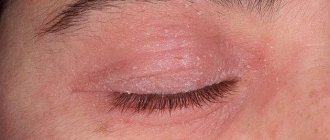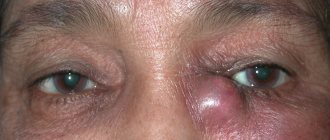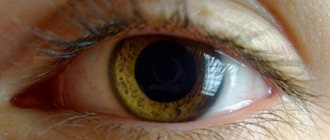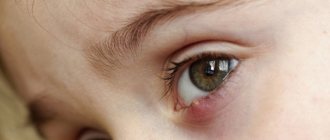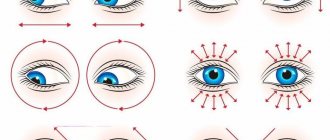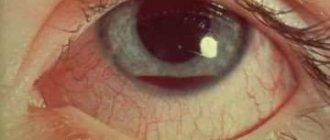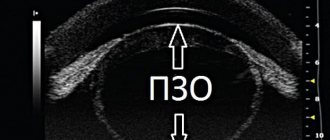Myopia, or in other words false myopia, is a pathological condition of the visual system. False myopia is also called tired eye syndrome. To a greater extent - this is about 65% of all cases, the disease manifests itself in children under the age of six. But, nevertheless, myopia quite often develops in adults. Treatment of false myopia should be carried out under the strict supervision of specialists. It should be comprehensive using several drug groups. Only in this case can the disease be overcome.
Causes of false myopia (pseudomyopia) in children and adults
The reasons include prolonged visual strain, which often leads to severe eye fatigue. As a result, a person loses the ability to clearly guide objects at a great distance. In other words, accommodation (spasm) begins to develop. Overstrain of the ciliary eye muscle, which is responsible for the movement of the lens and determines the necessary focusing of any lines and patterns, leads to disruption of its functioning.
The main causes of false myopia are:
- As already mentioned, the cause may be regular eye strain.
- Working at the computer for a long time or watching TV for a long time.
- Zinc deficiency in the body.
- Incorrect sleep and wakefulness patterns.
- Heavy strain on the eyes.
- Poor lighting in the home or workplace.
- Impaired blood supply to the organs of vision and the cervical spine.
- Mechanical eye injuries (in rare cases).
Preventing the occurrence of these factors that negatively affect vision will help reduce eye strain, which in turn will significantly reduce the risk of developing false myopia.
Hardware treatment of myopia
This method of therapy is suitable for all children from 2 years of age. In combination with glasses or contact vision correction, the result is very effective. These are the devices and techniques used today for the treatment and prevention of myopia.
- Infrared radiation. The therapeutic effect has a thermal effect, which increases blood circulation in the organs of vision and decreases muscle tone.
- Color pulse therapy. Glasses with built-in emitters are placed over the eyes. They produce light pulses with different wavelengths. At the same time, the blood supply to the eye structures improves, and the work of the lymphatic drainage system is activated.
- Laser therapy. At a distance of 8-10 cm from the child’s face there is a screen on which three-dimensional, constantly changing images are projected. By observing the transformation of their shapes and sizes, the work of the retinal nerve cells is stimulated, spatial vision improves, and accommodation is trained.
Hardware methods are used to treat true and false myopia. With regular courses, the positive effect is quite noticeable. For each child, the program of procedures is compiled individually. Hardware treatment shows good results for mild and moderate myopia.
Types of myopia
The so-called accommodation spasm is divided into several types:
- Artificial type of myopia. Appears during the period of exposure of the visual system to medications used for eye therapy (drops, tablets, solutions, eye rinses). This form of false myopia is short-term and will go away literally two days after you stop taking certain medications.
- Physiological type - develops as a result of constant overstrain of the visual organs. In most cases, this form of moderate and weak myopia occurs in people suffering from astigmatism or farsightedness.
- Mixed form of myopia. It implies the development of several forms of false myopia at once.
- Pathological form of myopia. It is caused by a sharp change in the focus of vision, which is why visual acuity decreases. In turn, the pathological form is divided into two subgroups: persistent and unstable.
Find out about high myopia here.
Do eye drops help with myopia?
Myopia is primarily associated with changes in the shape of the eyeball. Due to its elongation, light rays are refracted incorrectly, and the focal point is located in front of the retina. In this state, a person has difficulty seeing distant objects, and with a high degree of myopia, also near ones.
Myopia therapy involves correcting visual impairment using glasses or contact lenses. However, surgery remains the most effective and stable method of treating myopia. Surgical treatment of myopia is carried out only from adulthood, since until this age the human visual system is constantly developing.
For myopia, different eye drops can be prescribed, because in conditions of improper focusing, the eyes quickly get tired, symptoms of irritation and drying of the mucous membrane appear. Eye drops for myopia give good results only in combination with proper nutrition, visual exercises and optical correction.
Eye drops for eye fatigue and irritation are simply necessary for myopic people who are forced to work at a computer for a long time. Vitamin preparations will help normalize metabolism and improve tissue nutrition, which will have a beneficial effect on visual function. Drops to restore retinal functionality will also help preserve vision in myopia.
The advantage of drops in the symptomatic treatment of myopia is undeniable. There are different forms of anti-inflammatory and vitamin supplements, but only eye drops have a fairly quick effect. When using drops, the components do not enter the systemic circulation, so serious side effects are rarely observed. Tablets are less effective because they first pass through the gastrointestinal tract, enter the bloodstream and only then reach their target. In addition to the fact that many useful elements will be lost, the digestive organs will suffer from auxiliary components.
Symptoms of false myopia
Quite often, a spasm of accommodation appears completely suddenly and can cause discomfort to a person for several weeks or even months. The main sign of this phenomenon is poor visual focus, blurring of clear lines and pictures. With the further development of the pathology, other pronounced signs appear:
- a significant decrease in image clarity;
- • rapid fatigue of the visual organs occurs;
- burning and itching sensation in the eyes;
- migraines are common;
- lacrimation, development of conjunctivitis;
- blurry image.
Features of the course of myopia in adult patients:
- The perception of vision decreases, the image begins to blur.
- It is impossible to concentrate on an object because the field of vision is impaired.
- Feeling of regular discomfort in the eyes.
- Formation of pain in the eye area.
- Itching and burning sensation for a long time.
- The main feature is excessive fatigue of the visual organs.
- Eye pain is often accompanied by watery eyes.
- In the absence of treatment for myopia, hyperemia of the white membranes of the eyes begins to develop.
A couple of weeks after vision deterioration, the patient begins to experience attacks of headaches, mainly in the pubic and occipital parts. In exceptional cases, they appear quite often, which of course significantly reduces the quality of life of the affected person. This article will tell you about laser correction of myopia.
As a result of frequent spasms of accommodation, a person experiences a regular state of nervousness and irritability, with periodic loss of consciousness.
Myopia develops much more often in children than in adult patients. The main features of the course of the disease in children are:
- The child often rubs his eyes during games and walks and complains of itching.
- The baby experiences redness of the eyeballs throughout the entire period of the disease.
- When looking at distant objects, the child begins to squint, which in turn worsens the percentage of overall vision.
- The child is lethargic and does not eat well.
- In some cases, myopia is accompanied by an increase in body temperature.
- The baby may complain of regular headaches.
What are the treatment methods?
There are three main methods of treating false myopia, the use of which depends on the personal characteristics of the patient and the advanced state of the disease.
Drug treatment
This type of treatment is based on taking medications in the form of eye drops to dilate the pupil and improve the quality of vision. At the same time, the doctor prescribes a complex of vitamins rich in carotene and vitamin C, which help restore visual acuity, strengthen the body as a whole and improve immunity.
In addition, attention is paid to the treatment of identified chronic diseases that may contribute to the occurrence of relapses in the future.
Surgery
A more innovative method of treating false myopia is correcting vision defects using a laser. This treatment method is used in both children and adults.
This course of treatment is based on regular exposure of the affected eye to a laser, which starts the process of inhibiting the further development of the pathology. Over time, there is a gradual restoration of the functions of the visual organs.
Another new treatment method is therapy using an ultrasound machine. Its principle is that a set of procedures is applied to the eyes, which include:
- exposure to pulsed red radiation;
- pulsed infrared radiation;
- exposure to a magnetic field.
This course of treatment is carried out by improving blood circulation in the cervical spine, which helps relieve spasm and pain.
Treatment with various exercises
This treatment method is based on a set of exercises that help not only relax the ciliary muscle, but also promote its training. This type of therapy is carried out not only in the ophthalmologist’s office, but also at home. Only regular training helps to achieve positive results and restore normal function of the visual organs.
In addition, the doctor prescribes swimming and regular cycling, since during this the eye muscles experience completely different loads and thereby help relieve spasm of accommodation and restore visual acuity. In cases where the disease has developed against the background of scoliosis, the doctor prescribes a massage, which is performed by an experienced specialist, excluding the possibility of self-medication.
Differences between false myopia and true myopia
The differences are as follows: pseudomyopia occurs due to constant overstrain of the visual organs. As a result, a spasm of accommodation occurs, the clarity of vision decreases, and focus is disrupted when viewing objects in the distance. False myopia occurs when the ciliary muscle is unable to relax when quickly looking at distant objects. In addition, pseudomyopia is easy to treat. Read about electrical eye stimulation in children here.
True myopia is a chronic pathology that is not subject to any treatment. For this reason, in almost all cases of true myopia, a person is prescribed contact lenses or glasses. It is impossible to distinguish false myopia from true one without the help of specialists.
If you suddenly develop vision problems, you should immediately consult an ophthalmologist.
The doctor will help you accurately diagnose the disease and prescribe a course of effective treatment. This material will tell you about the treatment of convergent strabismus.
True myopia develops slowly and several years may pass from the onset of the disease to the appearance of the first signs.
How to treat low myopia
Is it possible to cure low myopia? This question can be answered positively. The method of treatment and its effectiveness depend primarily on the type of myopia. False myopia of the first degree is treated by relieving the spasm of accommodation and preventing its reappearance. True myopia requires a set of measures, which include:
- optical correction,
- drug support,
- surgical treatment (optional).
Optical correction
Vision correction using optics is not a treatment as such, since it does not affect the physiology of the eye, but it compensates for the refractive error, allowing the image to be focused on the retina. The correct selection of corrective products such as contact lenses or glasses allows the patient to get rid of the discomfort caused by myopia. With a slight degree of myopia, constant wearing of glasses may not be necessary - the patient puts them on only when there is a need to look at distant objects: while driving, in a movie theater, etc.
Only a doctor can prescribe adequate optical correction after a thorough diagnosis.
Drug treatment
When false myopia is diagnosed, to eliminate its symptoms, drops are prescribed to relieve the spasm of accommodation. This type of myopia can be called medically curable, since relaxation of the spasmodic muscles of the eye leads to the restoration of normal vision.
There are no medications that can cure even mild myopia. In this case, drug therapy is aimed primarily at strengthening the visual apparatus, which is achieved by prescribing a complex of vitamins and microelements that have a positive effect on eye health. There are even special vitamin complexes to maintain healthy vision.
Surgery
Complete cure of myopia, that is, restoration of good vision without lenses and glasses, can only be achieved by surgery: scleroplasty and laser vision correction. Scleroplasty surgery for minor myopia is rarely prescribed, only in cases of rapid progression. Much more often, patients resort to laser medicine: photorefractive keratectomy (PRK) and LASIK.
Elimination of refractive error using laser treatment is considered the most modern method, and for mild myopia such an operation is cheaper than for severe myopia. In 10-15 minutes, the laser changes the shape of the cornea, and vision is fully restored. The postoperative period lasts only a couple of days, after which the patient can enjoy restored full vision.
ethnoscience
Traditional methods for treating mild myopia include the use of medicinal decoctions and infusions of herbs and fruits containing the most important substances for eye health. They can be consumed by both children and adults, as well as during pregnancy, since all the substances are natural and healthy. Among them:
- Blueberries in all forms: jam, infusion of dried berries, fruit juice, fresh berries.
- Rose hips in the form of fruit infusion: two tablespoons per 500 ml of boiling water are infused for 8 hours, then the drug must be strained and drunk three tablespoons per day.
- Blackcurrant leaf tea: it contains many valuable substances, and at the same time it is pleasant to drink because it is aromatic and tasty.
- Stinging nettle. Pour 25 g of fresh or dry nettle leaves into 500 ml of boiling water and leave for at least 3 hours. Take the strained infusion 2 tbsp. l. morning and evening before meals.
The positive effect of folk recipes will increase if you combine the use of these remedies with regular eye exercises.
Diagnosis and treatment
Diagnostic measures are carried out by an ophthalmologist. It is possible to assume false myopia based on the complaints of the person who came to the appointment. But for accurate confirmation, it is necessary to undergo a number of diagnostic methods, based on the results of which a specialist will prescribe the necessary treatment. To confirm myopia, specialists use the following methods:
- Fundus examination. The essence of this method is as follows: the doctor puts an ophthalmic mirror on the head, in the middle of which there is a small hole and stands directly opposite the person. The doctor then places this mirror directly in front of the desired eye and directs the imaged rays into the pupil. Due to this, a specialist can examine the eyeball in detail, assess the condition of the visual organs, including the optic nerves, and diagnose the presence of myopia and other eye pathologies. Before the procedure, be sure to make sure that the doctor drops a drop of medicine into each eye in order to avoid dry eyes. No preparation is required for the procedure.
- Visual field examination. The essence of the method is as follows: the doctor sits opposite the person, in such a position that the patient’s left eye looks exactly into the doctor’s right eye, and the distance must be at least one meter. You need to look directly into the doctor's eye. After which the doctor places a small mark above the head, which the patient should not see. The specialist then moves the placed mark from the peripheral side to the center of the eye. The person must tell the doctor as soon as he removes the tag. If the patient notices the mark at the same time as the doctor, then both have normal visual fields. The study is carried out until the patient informs the doctor that he has noticed the mark. Otherwise, this study will not give accurate results.
- This is perhaps the simplest method for diagnosing false myopia. The essence of the method: the doctor sits on a chair opposite the patient and places a special lamp with light approximately one meter away from the eyes. And next to this lamp there is an ophthalmic mirror. The rays reflected from the mirror must pass through the cornea of the eye, then the rays penetrate the retina and are reflected from it. Due to this, the doctor determines the presence of myopia. If during the examination the doctor removes a red spot through the pupil of the eye, it means that the patient has problems. After diagnosis, the doctor will prescribe appropriate treatment.
How to stop progressive myopia
To prevent the progression of myopia, it must be detected in time and treatment chosen.
During visual work, you need to take breaks and do exercises to strengthen your eye muscles. Participating in sports that do not require significant stress is of great importance.
The menu should include foods containing calcium, magnesium, zinc, vitamins A and E.
Glasses and lenses
Glasses should be selected according to the size of the face. If necessary, the optical power of the lenses may differ for each eye. Patients are prescribed bifocal lenses as needed. They provide optimal correction at different distances.
Medicines
The following medications are prescribed for the treatment of myopia:
- calcium preparations;
- cysteine;
- ginseng preparations;
- lemongrass extract;
- mesatone;
- oxygen injections under the conjunctiva;
- vitamins and complex products containing ascorbic acid.
Scleroplasty
The operation is prescribed when the anteroposterior size of the eyeball is more than 24 mm. Scleroplasty does not improve visual acuity, but stops the progression of the disease. It is indicated for:
- ineffectiveness of glasses;
- progressive lengthening of the eye;
- a steady decrease in visual acuity;
- complications of myopia - retinal dystrophy, hemorrhages in the eye;
- malignant course of the disease.
Keratotomy
If the lenses do not provide acceptable vision correction, and the person does not want to wear glasses, a keratotomy is prescribed. In this case, the refractive power of the cornea of the eye is changed by applying incisions to it. Subsequently, this membrane becomes covered with microscopic scars.
The standard operation time is no more than 20 minutes. It is done using local anesthesia. The patient remains in the eye clinic for several hours and is then discharged home.
Keratotomy can be performed for myopia of no more than 6 diopters.
Laser correction
- cataract and glaucoma;
- malignant form of progressive myopia;
- diabetes;
- installed pacemaker;
- thinning of the cornea and keratoconus;
- eye infections;
- pregnancy.
As a rule, laser correction is not performed on people under 21 years of age. There is a possibility of developing complications:
- inflammatory and allergic reactions;
- hemorrhages;
- displacement of the cornea;
- decreased clarity of vision in twilight conditions.
Implantation of intraocular lenses
Intraocular (phakic) lenses are used to treat high degrees of myopia. The most popular artificial lenses are:
- multifocal lenses, which maximally imitate the functioning of the lens and provide almost one hundred percent vision correction;
- lenses with a yellow filter that protects the retina from blue light radiation;
- Aspherical lenses provide good vision in the evening.
Drops
Depending on the type of lesion and the course of the disease, different types of eye drops may be prescribed. The best of them are described below. Read about the prevention of myopia in children at this link.
Promoting relaxation of the ciliary muscle
- Emoxipine - this product has a synthetic base and is used only in ophthalmic practice. Allows you to reduce the viscosity of blood in the eyes, reduces the percentage of vascular permeability. The dosage of the drug is determined only by a specialist; self-medication is dangerous to health. Emoxipin eye drops are instilled 2 drops into each eye 3 times a day. The course of therapy is from 4 to 30 days. The duration of the course primarily depends on the severity of the disease. The maximum dosage per day should not exceed 0.5 ml. Contraindications are: the period of pregnancy, regardless of trimester, and individual intolerance to the components;
- Irifrin is an eye drop that has mydriatic activity (promotes pupil dilation). Intended for local use. 2.5% drops begin to be used from the age of six, 1 drop before bed every day for one month. If myopia has a complicated course, the patient is prescribed 10% drops for the treatment of adults and children over 12 years of age. Instill one drop before bedtime for two weeks.
The use of Irifrin is not advisable in the following cases: with hypersensitivity to the components of the drug, with glaucoma, regardless of the type, with eye injuries, during the rehabilitation period after eye surgery.
- Visine is an ophthalmic agent produced in the form of drops. It has a small list of contraindications and side effects, which is why it gained popularity. These eye drops are instilled 1-2 drops into each conjunctival sac 3 times a day. If an allergic reaction develops, you should immediately stop using the drug. Contraindications: the patient has a history of an allergic reaction to the components of the drug, surges in blood pressure, hyperthyroidism, dry eye syndrome.
To relieve accommodative spasm
- Midriacil is a new ophthalmic drug for relieving accommodative spasm. The drug is available only in the form of eye drops. Used for complex treatment of diseases of the organs of vision. Drops are instilled twice a day, one drop in each eye. It is prohibited to use: with increased sensitivity to the drug, with glaucoma, especially mixed type, with intraocular pressure and children under 6 years of age;
- Cyclomed is an ophthalmic drug used to treat eye pathologies. The product is used for two weeks. Apply one drop to the eyes every three hours. Contraindications are: individual intolerance to the drug, glaucoma, lactation period.
Prevention
It is impossible to completely avoid the manifestations of accommodation spasm, especially in childhood, since modern children spend too much time “in the company” of computers, mobile phones, and tablets. Therefore, the main method of fighting to preserve vision is prevention:
- Limiting the time devoted to computer communication;
- If hard work is necessary, mandatory breaks every 0.5 hours with gymnastics;
- Good lighting helps the eyes work and, therefore, reduces their tension;
- The presence in the diet of elements necessary for normal eye function (zinc, manganese, chromium, selenium, copper, etc.), vitamins, and proteins.
What is pachymetry
The definition of the disease atrial scotoma is described in this article.
Garfort eye drops with instructions https://eyesdocs.ru/medicinaoperacii/lekarstva/glaznye-kapli-ganfort-opisanie-i-pravila-primeneniya.html
Preventive examinations by an ophthalmologist can detect any abnormalities in eye function at a very early stage.
Don't forget that the level of general immunity can have a significant impact on the health of the eyes and their ability to maintain functionality. Of particular importance here is normal motor activity, which ensures good blood circulation and contributes to the supply of all tissues and organs with nutrients.
Visual gymnastics
Gymnastics for the eyes trains vision and improves accommodation of the visual organs.
- Determine the farthest point on the horizon. Extend your arms forward and point your index finger at a given point. Move your eyes from a given point to the tip of your finger 12 times.
- Use the tip of your index finger to touch the tip of your nose. At the same time, do not take your eyes off your finger, try to focus on the tip of your finger. Repeat the exercise 10 times.
- Draw a small dot on the glass. Direct your attention to this point and then sharply shift your vision to the street or a certain object. Then again focus on the point and shift your vision again. Repeat the exercise for seven minutes.
If possible, give your eyes a rest throughout the working day. Do simple exercises and follow all the necessary recommendations from specialists. And you won't know what myopia is.
Mandatory payment document details
A payment is a document that must contain mandatory details.
In 2020, the Ministry of Construction issued a decree that approved the approximate form of the payment document. I draw attention to the word “approximate”, i.e.
service organizations can use it as a guide, but are not required to copy it word for word.
Main elements of the document:
- Payer's personal account. It is easy to pay for services via the Internet or ATM.
- The month for which the amount due was accrued.
- Information about the payer: Full name, address of the residential premises, its area, number of residents living in the apartment or house.
- Information about the service provider: company name, phone number, website and other contact information.
- Meters data.
- The largest section is the calculation of necessary payments for utilities.
- Reference information regarding units of measurement and consumption standards.
- Information about recalculations, if any.
Almost all modern receipts have a QR code and barcode. They are needed to pay bills online via the Internet or telephone, or through ATMs. And barcodes are often used by operators in banks and cash settlement centers.
How to diagnose?
At the first symptoms of visual impairment, you should consult an ophthalmologist. At the appointment, the doctor determines the true cause of the pathology and prescribes treatment only based on the test results.
To diagnose a spasm of accommodation, the following is carried out:
- Vision test. At a distance of 5 meters, the patient is asked to look at several rows of letters on Sivtsev’s table. This test determines how many diopters your vision has decreased.
- Convergence research. This study shows how coordinated the eyes are when observing a moving object. During the test, this object becomes the ophthalmologist's finger.
- Computer refractometry. During this study, the optical characteristics of the eye and its ability to refract in a relaxed state are determined.
- Accommodation study. In this test, the doctor determines how much a given lens can change shape to allow clear vision at different distances.
- Shadow test. This test shows how the fundus of the eye reflects light that hits it.
This is where diagnostic measures in adults usually end.
Video for those whose eyes feel tired after a working day, there is a veil before the eyes and vision deteriorates when looking at objects in the distance, but after rest and relaxation these signs go away:
REFERENCE: To diagnose the causes of false myopia in children, consultations with a pediatrician, orthopedist and neurologist are scheduled.
